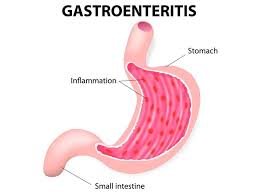Gastroenteritis: Causes, Symptoms, Treatment, and Prevention Strategies
Gastroenteritis, commonly known as the stomach flu or stomach bug, is a widespread gastrointestinal infection characterized by inflammation of the stomach and intestines. While often referred to as a mild illness, gastroenteritis can cause significant discomfort and disruption to daily life. In this comprehensive guide, we will delve into the causes, symptoms, treatment options, and preventive measures for gastroenteritis, providing valuable insights for individuals seeking to understand and manage this common ailment.
Understanding Gastroenteritis: Gastroenteritis is typically caused by viral, bacterial, or parasitic infections that result in inflammation of the gastrointestinal tract. The most common viruses responsible for gastroenteritis include norovirus, rotavirus, and adenovirus, while bacterial pathogens such as Salmonella, Escherichia coli (E. coli), Campylobacter, and Clostridium difficile can also trigger the condition. Additionally, certain parasites such as Giardia lamblia and Cryptosporidium can cause gastroenteritis, particularly in cases of contaminated food or water.
Symptoms of Gastroenteritis: The symptoms of gastroenteritis can vary in severity and duration depending on the underlying cause of the infection. Common symptoms may include:
- Diarrhea: Loose, watery stools that may be accompanied by abdominal cramps, bloating, and urgency to use the restroom.
- Nausea and vomiting: Feeling nauseous or vomiting may occur, especially in cases of viral gastroenteritis.
- Abdominal pain and cramping: Discomfort or cramping in the abdominal region may be present due to inflammation of the gastrointestinal tract.
- Fever: A low-grade fever may develop as the body’s immune system responds to the infection.
- Dehydration: Loss of fluids through diarrhea and vomiting can lead to dehydration, characterized by symptoms such as dry mouth, decreased urination, dizziness, and fatigue.
Diagnosis and Treatment: Diagnosing gastroenteritis typically involves a thorough medical history, physical examination, and assessment of symptoms. In some cases, laboratory tests such as stool cultures or tests for viral antigens may be performed to identify the causative agent of the infection. Treatment options for gastroenteritis may include:
- Fluid replacement: Rehydration is a crucial aspect of managing gastroenteritis, particularly in cases of dehydration. Drinking clear fluids such as water, oral rehydration solutions, broth, or electrolyte drinks can help replace lost fluids and electrolytes.
- Symptomatic relief: Over-the-counter medications such as anti-diarrheals (e.g., loperamide) and antiemetics (e.g., ondansetron) may be used to alleviate diarrhea and vomiting, respectively. However, these medications should be used with caution and under the guidance of a healthcare professional, especially in children and older adults.
- Antibiotics: In cases of bacterial gastroenteritis, antibiotics may be prescribed to target the specific bacterial pathogen responsible for the infection. However, antibiotics are not effective against viral or parasitic gastroenteritis and may not be necessary in all cases.
- Rest and nutrition: Resting and avoiding solid foods for a brief period can help the digestive system recover from gastroenteritis. Gradually reintroducing bland, easily digestible foods such as rice, bananas, toast, and applesauce (BRAT diet) can help alleviate symptoms and prevent further irritation of the stomach and intestines.
Prevention Strategies: Preventing gastroenteritis involves practicing good hygiene and minimizing exposure to infectious agents. Key preventive measures may include:
- Hand hygiene: Washing hands thoroughly with soap and water before eating, after using the restroom, and after handling contaminated objects or surfaces can help prevent the spread of gastroenteritis-causing pathogens.
- Food safety: Proper food handling, storage, and preparation can reduce the risk of foodborne illnesses. This includes cooking foods to the appropriate temperature, avoiding cross-contamination between raw and cooked foods, and consuming perishable foods promptly.
- Water sanitation: Drinking clean, safe water and avoiding untreated or contaminated water sources can reduce the risk of waterborne illnesses such as cryptosporidiosis and giardiasis.
- Vaccination: Vaccines are available for certain types of viral gastroenteritis, such as rotavirus, which primarily affects infants and young children. Routine vaccination according to the recommended schedule can help prevent gastrointestinal infections and their complications.
Conclusion: Gastroenteritis is a common gastrointestinal infection that can cause significant discomfort and disruption to daily life. By understanding the causes, symptoms, treatment options, and preventive measures associated with gastroenteritis, individuals can take proactive steps to minimize their risk of infection and effectively manage symptoms if they occur. Practicing good hygiene, food safety, and water sanitation habits can go a long way in preventing the spread of gastroenteritis-causing pathogens and promoting overall health and well-being for individuals and communities alike.
Thanks for visiting Gymbag4u.com
You may also love reading our following articles. Digestive Health: A Comprehensive Guide to Optimal Gut Function – GymBag4U and Natural Digestive Enzymes: What to Eat After Every Meal for Better Digestion – GymBag4U and Irritable Bowel Syndrome (IBS): Causes, Symptoms, and Treatment – GymBag4U and Weight Watcher: A Sustainable Weight Management Program – GymBag4U
